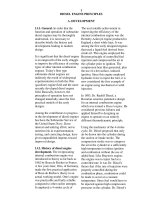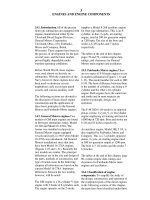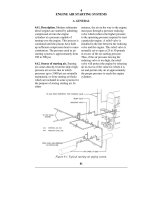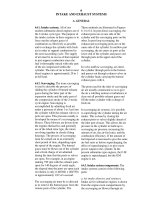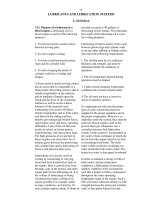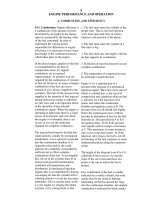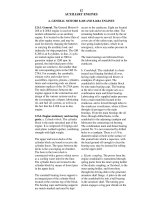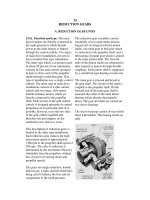Tài liệu Diezel 1410 P1
Bạn đang xem bản rút gọn của tài liệu. Xem và tải ngay bản đầy đủ của tài liệu tại đây (618.36 KB, 23 trang )
1
DIESEL ENGINE PRINCIPLES
A. DEVELOPMENT
1A1. General. In order that the
function and operation of submarine
diesel engines may be thoroughly
understood, it is necessary to
describe briefly the history and
development leading to modern
design.
It is significant that the diesel engine
is an outgrowth of the early struggle
to improve the efficiency of existing
types of other internal combustion
engines. Today's fleet type
submarine diesel engines are
indirectly the result of widespread
experimentation in both the Otto
(gasoline) engine field and the more
recently developed diesel engine
field. Basically, however, the
principles of operation have not
changed materially since the first
practical models of the early
designs.
Among the contributors to progress
in the development of diesel engines
has been the Submarine Service of
the United States Navy. Keen
interest and untiring effort, not to
mention risk in experimentation,
testing, and correcting design, have
given unparalleled impetus toward
improved design.
1A2. History of diesel engine
development. The reciprocating
internal combustion engine was
introduced in theory as far back as
1862 by Beau de Roches in France.
A few years later, Otto, of Germany,
made the first practical application
of Beau de Roches's theory in an
actual working model. Otto's engine
was practicable and fairly reliable
compared to other earlier attempts.
It employed a 4-stroke cycle of
The next notable achievement in
improving the efficiency of the
internal combustion engine was the
Hornsby-Ackroyd engine produced in
England a short while later. It was
among the first early designed engines
that used a liquid fuel derived from
crude oil. This engine employed the
Brayton principle of controlled fuel
injection and compressed the air in
the cylinder prior to ignition. The
compression heat thus generated, plus
the use of a hot surface, induced
ignition. Since this engine employed
hydraulic force to inject the fuel, it is
now considered the first example of
an engine using mechanical or solid
injection.
In 1893, Dr. Rudolf Diesel, a
Bavarian scientist, patented a design
for an internal combustion engine
which was termed a Diesel engine. He
considered previous failures and
applied himself to designing an
engine to operate on an entirely
different thermodynamic principle.
Using the mechanics of the 4-stroke
cycle, Dr. Diesel proposed that only
air be drawn into the cylinder during
the suction or intake stroke. The
compression stroke was to compress
the air in the cylinder to a sufficiently
high temperature to induce ignition
and combustion without the use of
added heat. Like Brayton's engine,
this engine was to inject fuel at a
controlled rate. It was Dr. Diesel's
theory that if the rate of injection were
properly controlled during the
combustion phase, combustion could
be made to occur at a constant
temperature. Since fuel would have to
be injected against high compression
pressures in the cylinder, Dr. Diesel's
operation using gas as a fuel. Thus,
the 4-stroke cycle of a gas engine
became popularly known as an Otto
cycle.
George Brayton, an American,
introduced a new principle of fuel
injection in 1872. Brayton used an
internal combustion gas engine in
his experiments. He demonstrated
that prolonging the combustion
phase of the cycle, by injecting fuel
at a controlled rate, produced more
power per unit of fuel consumed.
However, much of the efficiency
gained by this method was lost due
to the lack of an adequate method of
compressing the fuel mixture prior
to ignition.
design called for fuel injection to be
accomplished by a blast of highly
compressed air. Essentially, this was
air injection. Dr. Diesel further
theorized that the temperature drop
during the expansion phase of the
cycle would be efficient to make
external cooling of the combustion
chamber unnecessary.
A single-cylinder working model was
constructed and first experiments
were conducted using coal dust as a
fuel. All efforts to operate
1
a working model on the cycle
proposed by Dr. Diesel resulted in
explosions and failure. Further
attempts to experiment along this
same line were abandoned.
Consequently, an engine operating
entirely on the theoretical cycle
proposed by Dr. Diesel was never
produced. This cycle subsequently
became known as the diesel cycle.
Many designers realized the value o
f
the practical elements in the cycle of
operation outlined by Dr. Diesel.
Subsequently, experimenters began
to achieve favorable results by
eliminating the impractical elements
and by altering the cycle of
operation. Successful experiments
were conducted by the Machinen-
fabrik-Augsburg-Nurnberg
(commonly called MAN) concern in
Germany.
By this time the more volatile
petroleum fuels were in common use
and diesel engines utilizing liquid
fuel were designed. These engines
operated on a cycle in which the
and, in addition, many of these
engines gave off considerable carbon
monoxide fumes, creating a menace
to personnel.
In the meantime, MAN built and
experimented with 2-stroke cycle
diesel engines for submarine
propulsion. However, insufficient
progress had been made in metallurgy
to provide metals capable of
withstanding the greater heat and
stress inherent in engines of this type.
MAN then turned its efforts toward
production of a 4-stroke cycle diesel
engine capable of developing 1000
hp. While fairly successful, these
engines eventually developed
structural weaknesses at the
crankcase.
By 1914 the MAN 4-stroke cycle
diesel had been partially redesigned
and strengthened, producing the
SV45/42, 1200-hp engine used in the
majority of German submarines
during World War I. Following World
War I, the United States Navy
acquired a number of these engines
combustion phase occurred at
constant pressure rather than at
constant temperature. Experience
also disclosed that it was essential to
cool the combustion chamber
externally. Early diesel engines
operating on the constant pressure
cycle, were efficient enough to make
commercial production feasible.
Progress in diesel engine design has
been rapid since the early models
were introduced. The impetus of war
demands, progress in metallurgy,
fabrication, and engineering, and
refinements in fuels and lubricants
have all served to produce modern,
high-speed diesel engines of
exceptional efficiency.
1A3. History of submarine engine
development. The first United
States submarines utilizing internal
combustion engines for propulsion
were powered by 45-horsepower, 2-
cylinder, 4-stroke cycle gasoline
engines produced by the Otto
Company of Philadelphia.
Meanwhile, the English Submarine
Service made use of 12- and 16-
cylinder gasoline engines in their
earlier submarines.
The inherent hazards accompanying
the use of such a highly volatile fuel
as gasoline were quickly realized.
Stowage was a constant problem and
handling of the fuel was extremely
dangerous. Internal explosions were
frequent
for use in the earlier S-class boats. A
copy of this engine was produced by
the New York Navy Yard and used in
other early S-class submarines.
The Electric Boat Company, which
was formerly the Holland Torpedo
Boat Company, became licensee in
the United States for the MAN
Company of Germany. Later, the
Electric Boat Company consolidated
with the New London Ship and
Engine Company. Shortly before
World War I, the Electric Boat
Company developed the well-known
NELSECO engine. During, and
subsequent to World War I, a number
of United States submarines of the O,
R, and S classes were equipped with
these NELSECO engines. In fact, the
principal installations in United States
submarines were 6- and 8-cylinder
NELSECO's until about 1934.
Prior to 1930 the engines used in most
submarines of all the larger naval
powers, with the exception of Great
Britain, were 4-stroke cycle diesel
engines. The United States Navy,
however, experimented with a 2-
stroke cycle Busch-Sulzer engine and
equipped a number of boats with this
type of engine. Since then, the
majority of engines designed for
United States submarine use have
been of the 2-stroke cycle type.
2
Prior to 1929, all engines in the
United States Submarine Service
were of the air injection type.
Shortly after 1929, mechanical or
solid type injection was employed
on MAN engines. The advantages to
be obtained with this type of
injection were immediately
1A4. How submarine requirements
affect engine design. The fact that
submarines are both subsurface and
surface vessels places definite
restrictions upon size, hull design, and
shape. Total weight, too, is a factor
having considerable bearing on
underwater operations. Hull
apparent. By using solid type
injection, the weight of the engines
could be considerably reduced. The
elimination of the air compressor
alone accounted for a saving in
weight of approximately 14 percent.
The advantages derived from the use
of mechanical injection were
numerous and included:
1. simplification of design
2. reduction in length of the
engine
3. greatly reduced weight per
horsepower
4. reduced fuel consumption
5. improved load balance in the
engine
6. far greater reliability
7. less maintenance
The need for more powerful engines
became apparent with the
development of the fleet type
submarine. The three engines that
seemed to fulfill submarine
requirements were the Winton V-
type, now known as the General
Motors engine; the Fairbanks-Morse
opposed piston type; and the
Hooven-Owen-Rentschler double-
acting type engine. Of these, the
HOR was later removed from
submarines in favor of the General
Motors and Fairbanks-Morse
engines which are now the two
standard submarine engines.
At the present time, the General
Motors Corporation manufactures
16-cylinder, single-acting engines
rated at 1600 brake horsepower
(bhp) for main engine installations,
and 8-cylinder engines for auxiliary
installations. Fairbanks Morse and
Company manufactures 9- and 10-
cylinder, opposed piston engines
rated at 1600 bhp for main engine
installations, and 7-cylinder,
opposed piston engines for auxiliary
characteristics restrict engine size and
location of the engine compartments.
Engine weight must bear a
proportionate relationship to the
weight and displacement of the vessel
as well as to power requirements.
In the first engine-powered
submarines, the engines were
mechanically connected directly to
the propeller shafting. This design,
known as direct drive, developed
immediate operational problems. The
hull characteristics definitely fixed the
angle of the propeller shafting. This
restriction also determined engine
position and location. Also, the most
efficient propeller speeds did not
correspond with the most efficient
engine speeds. In direct drive
installations, critical speeds (or
synchronous torsional vibrations)
which were inherent in the early
model engines, were transferred
through the direct drive into shafting
and propellers. At times, the exact
cruising speed desired could not be
obtained, as it was necessary to pass
the engines through critical speeds in
the desired operating range as rapidly
as possible. Two major problems
were brought to the foreground by
these early models:
1. How to power the propellers and
yet separate engines and propeller
shafting so that no mechanical unity
existed.
2. How to design a drive in which
different and varied rotative speeds
could be selected for both engines and
propellers.
Various types and combinations of
drives were designed and tested. Over
a period of time it became apparent
that the electric drive installations
(commonly referred to as diesel-
electric drive) were the practical
solution. This type of design solved
installations. These engines have
proved most efficient. They weigh
as little as 15 to 20 pounds per bhp
including auxiliary equipment.
Standardizing on only two designs
has also made it possible to mass
produce engines with a minimum
amount of delay and difficulty.
both of the major problems. The
engines were coupled only to the
generators that supplied power to the
electric motors. The propeller shafting
was driven by the motors through
reduction gears or directly
3
by slow-speed electric motors. The
only connections between engine
power and propeller shafting were
electrical. Hence, vibrations
developed by the engines could not
be conducted to the propeller
shafting and propellers, and the
various stresses encountered by the
propellers could not be transmitted
directly to the engines as was the
case with mechanical couplings.
In addition, the rotative speed of the
engine was no longer limited by the
rpm of the propellers. Consequently,
the engines could be designed for
any desired speed within a selected
range. Likewise, the propellers
could be operated independently of
engine speed within the speed limits
of their design. The diesel-electric
drive gave greater latitude to
designers with respect to operating
speed, size, and location of engines.
It also gave the boat designers
greater freedom in placement of
engine compartments.
There are eight major requirements
that a submarine diesel engine
should fulfill:
1. The engine should furnish
maximum amount of power with
minimum weight and space
requirement.
2. The engine should possess the
ability to develop occasionally more
than full load rating.
3. The engine should have the ability
to run continuously at slightly less
than full load rating.
4. The engine should operate with
small fuel consumption per unit of
horsepower.
5. The engine should have a small
lubricating oil consumption.
6. All wearing parts should be readily
accessible for quick replacement.
7. There should be perfect balance
with respect to primary and secondary
forces and couples.
8. Major critical speeds within the
operating ranges of the engine should
be eliminated.
B. PRINCIPLES Of DESIGN AND OPERATION
1B1. Reciprocating internal
combustion engines. An engine that
converts heat energy into work by
burning fuel in a confined chamber
is called an internal combustion
engine. Such an engine employing
charge of fuel and air is admitted, and
the process is repeated. The above
sequence of events is called a cycle of
operation.
1B2. Cycles of operation. The word
back-and-forth motion of the pistons
is called a reciprocating type
internal combustion engine. The
diesel engine and the gasoline
engine are the most familiar
examples of reciprocating internal
combustion engines.
The basic principle of operation of
an internal combustion engine is
relatively simple. The space in the
cylinder in which the fuel is burned
is called the combustion chamber.
Fuel and air are admitted to the
combustion chamber and ignited.
The resulting combustion increases
the temperature within the
combustion chamber. Gases,
released by combustion, plus the
increase in temperature, raise the
pressure which acts on the piston
crown, forcing the piston to move.
Movement of the piston is
transmitted through other parts to
the crankshaft whose rotary motion
is utilized for work. The expended
gases are ejected from the cylinder,
a new
cycle enters into the description of the
operation of any internal combustion
engine. As applied to internal
combustion engines, it may be
defined as the complete sequence of
events that occur in the cylinder of an
engine for each power stroke or
impulse delivered to the crankshaft.
Those events always occur in the
same order each time the cycle is
repeated.
Each cycle of operation is closely
related to piston position and
movement in the cylinder. Regardless
of the number of piston strokes
involved in a cycle, there are four
definite events or phases that must
occur in the cylinders.
1. Either air or a mixture of air and
fuel must be taken into the cylinder
and compressed.
2. The fuel and air mixture must be
ignited, or fuel must be injected into
the hot compressed air to cause
ignition.
4
3. The heat and expansion of gases
resulting from combustion must
perform work on the piston to
produce motion.
4. The residual or exhaust gases
must be discharged from the
cylinder when expansion work is
completed.
The cycles of operation in each type
of internal combustion engine are
characterized both by the mechanics
of operation and the thermodynamic
processes. The three most
commonly known cycles are the
Otto cycle, the diesel cycle, and the
modified diesel cycle.
1B3 Thermodynamics. To explain
Matter is anything having weight and
occupying space. Solids, liquids, and
gases are matter.
A molecule is the smallest division of
a given matter, which, when taken
alone, still retains all the properties
and characteristics of the matter.
Heat is a form of energy caused by
the molecular activity of a substance.
Increasing the velocity of molecular
activity in a substance increases the
amount of heat the substance
contains. Decreasing the velocity of
molecular activity in a substance
decreases the amount of heat the
substance contains.
Temperature is a measure of the
thermodynamics as used in an
engineering sense, it is first
necessary to define the term and the
related terms used with it.
Thermodynamics is the science that
deals with the transformation of
energy from one form to another. A
basic law of thermodynamics is that
energy can neither be created nor
destroyed but may be changed from
one form to another. In diesel
engineering, we are concerned
primarily with the means by which
heat energy is transformed into
mechanical energy or work.
Force is that push or pull which
tends to give motion to a body at
rest. A unit of force is the pound.
Pressure is force per unit area acting
against a body. It is generally
expressed in pounds per square inch
(psi).
Work is the movement of force
through a certain distance. It is
measured by multiplying force by
distance. The product is usually
expressed in foot-pounds.
Power is the rate of doing work, or
the amount of work done in unit
time. The unit of power used by
engineers is the horse power (hp).
One horsepower is equivalent to
33,000 foot-pounds of work per
minute or 33,000/60 = 550 foot-
pounds per second.
Energy is the ability to perform
work. Energy is of two types:
kinetic, which is energy in motion,
and potential, which is energy stored
up.
intensity of heat and is recorded in
degrees by a thermometer. The two
temperature scales most commonly
used are the Fahrenheit and centigrade
scales.
Volume may be described as the
amount of space displaced by a
quantity of matter.
1B4. The mechanical equivalent of
heat energy. The function of an
internal combustion engine is to
transform heat energy into mechanical
energy. Recalling the basic law of
thermodynamics we know that energy
cannot be destroyed. It is possible to
convert mechanical energy to heat
completely, and by delicate physical
experiments it has been found that for
every 778 foot-pounds of mechanical
energy so converted, one Btu of heat
will be obtained. Because of
fundamental limitations, it is usually
not possible to convert heat
completely to work, but for every Btu
that is converted, 778 foot-pounds
will be realized. This important
constant is known as the mechanical
equivalent of heat.
1B5. Relationship of pressure,
temperature, and volume. Figure 1-
1A illustrates a simple cylinder with a
reciprocating piston. A dial pressure
gage at the top of the cylinder
registers pressure inside the cylinder.
Temperature inside the cylinder is
recorded by a thermometer. The
thermometer at the side registers room
temperature. The piston is at outer
dead center in its stroke. At this stage,
the pressure inside
5
Fi
gure 1-1. Pressure, temperature, and volume relationship in a cylinder.
the cylinder is the same as
atmospheric pressure outside, and
the dial of the pressure gage
registers 0. Also, the temperature
inside the cylinder is the same as
room temperature, or approximately
70 degrees F.
In Figure 1-1B, force has been
applied to the piston, moving it
about a third of the distance of its
compression stroke. Air trapped in
the cylinder is compressed. As the
volume of this air is decreased, the
pressure is increased to about 155
psi. The temperature rises from 70
degrees F to about 300 degrees,
indicating that heat has been added
to the air in the cylinder. This shows
that mechanical energy, in the form
of force supplied to the piston, has
been transformed into heat energy in
the compressed air.
In Figure 1-1C, more force has been
applied to the piston, raising the
pressure in the cylinder to about 300
psi, and the temperature to nearly
700 degrees F.
Figure 1-1D shows the final stage of
the compression stroke as the piston
arrives at inner dead center. Pressure
is in the neighborhood of 470 psi
and the temperature is about 1000
conditions found in the compression
stroke of a modern submarine diesel
engine. The temperature of the
compressed air within the cylinder has
been raised to a sufficient degree to
cause automatic ignition on the
injection of fuel oil into the cylinder.
Thus, in summation, we see that
during a cycle of operation, volume is
constantly changing due to piston
travel. As the piston travels toward
the inner dead center during the
compression stroke, the air in the
cylinder is reduced in volume.
Physically, this amounts to reducing
the space occupied by the molecules
of air. Thus, the pressure of the air
working against the piston crown and
walls of the cylinder is increased and
the temperature rises as a result of the
increased molecular activity. As the
piston nears inner dead center, the
volume is reduced rapidly and the
temperature increases to a point
sufficient to support the automatic
ignition of any fuel injected.
Combustion changes the injected fuel
to gases. After combustion, the
liberation of the gases with a very
slight increase in volume causes a
sharp increase in pressure and
degrees F. This illustration closely
approximates the
6
Fi
gure 1-1. Pressure, temperature, and volume relationship in a cylinder.
temperature. During the power
stroke, volume increases rapidly,
and toward the end of the stroke,
pressure and temperature decrease
rapidly.
1B6. Pressure-volume diagrams.
Various methods and devices are
used for measuring and recording
the pressures at various piston
positions during a cycle of operation
in an engine cylinder. The result
may be graphically illustrated by a
diagram such as that shown in
Figure 1-2. Such diagrams are
known as pressure-volume
diagrams. In practice, they are
referred to as indicator cards.
Pressure-volume diagrams give the
relationship between pressures and
piston positions, and may be used to
measure the work done in the
cylinder. Also, if the speed of the
engine and the time involved in
completing one cycle are known, the
indicated horsepower may be
computed by taking pressure-
volume diagrams on each cylinder
and converting the foot-pounds per
1B7. Pressure-volume diagrams for
the Otto cycle, diesel cycle, and
modified diesel cycle. Figure 1-2
shows typical pressure-volume
diagrams for the three types of engine
cycles. Each pressure-volume
diagram is a graphic representation of
cylinder pressure as related to
cylinder volume. In the diagrams the
ordinate represents pressure and the
abscissa represents volume. In actual
practice, when an indicator card is
taken on an engine, the vertical plane
is calibrated in pressure units and the
volume plane is calibrated in inches.
The volume ordinate of the diagram
then shows the length of stroke of the
piston which is proportional to the
volume.
Letters are located on each of the
figures in the diagrams. The distance
between two adjacent letters on the
figures is representative of a phase of
the cycle. Comparing the diagrams
provides a visible means of
comparing the variation in the phases
between the three cycles.
1B8. The Otto cycle. The Otto cycle
